Accounting for Business: Profitability, Investment Appraisal Report
VerifiedAdded on 2023/06/18
|10
|1313
|453
Report
AI Summary
This accounting report provides a detailed analysis of key financial concepts and decision-making processes within a business context. It includes a break-even analysis, calculating the break-even point in units and monetary terms, and examines the margin of safety. The report also explores profit s...
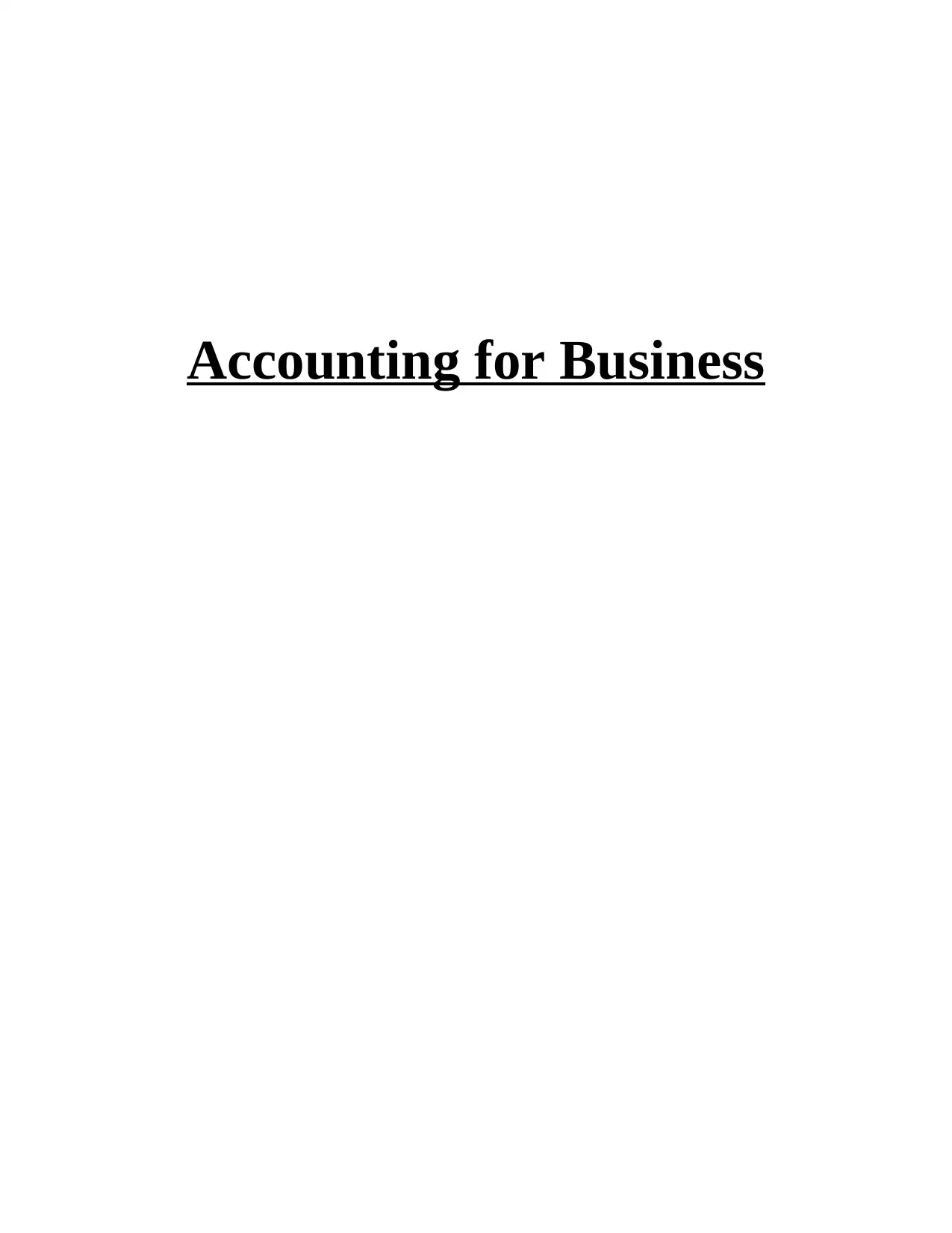
Accounting for Business
Paraphrase This Document
Need a fresh take? Get an instant paraphrase of this document with our AI Paraphraser
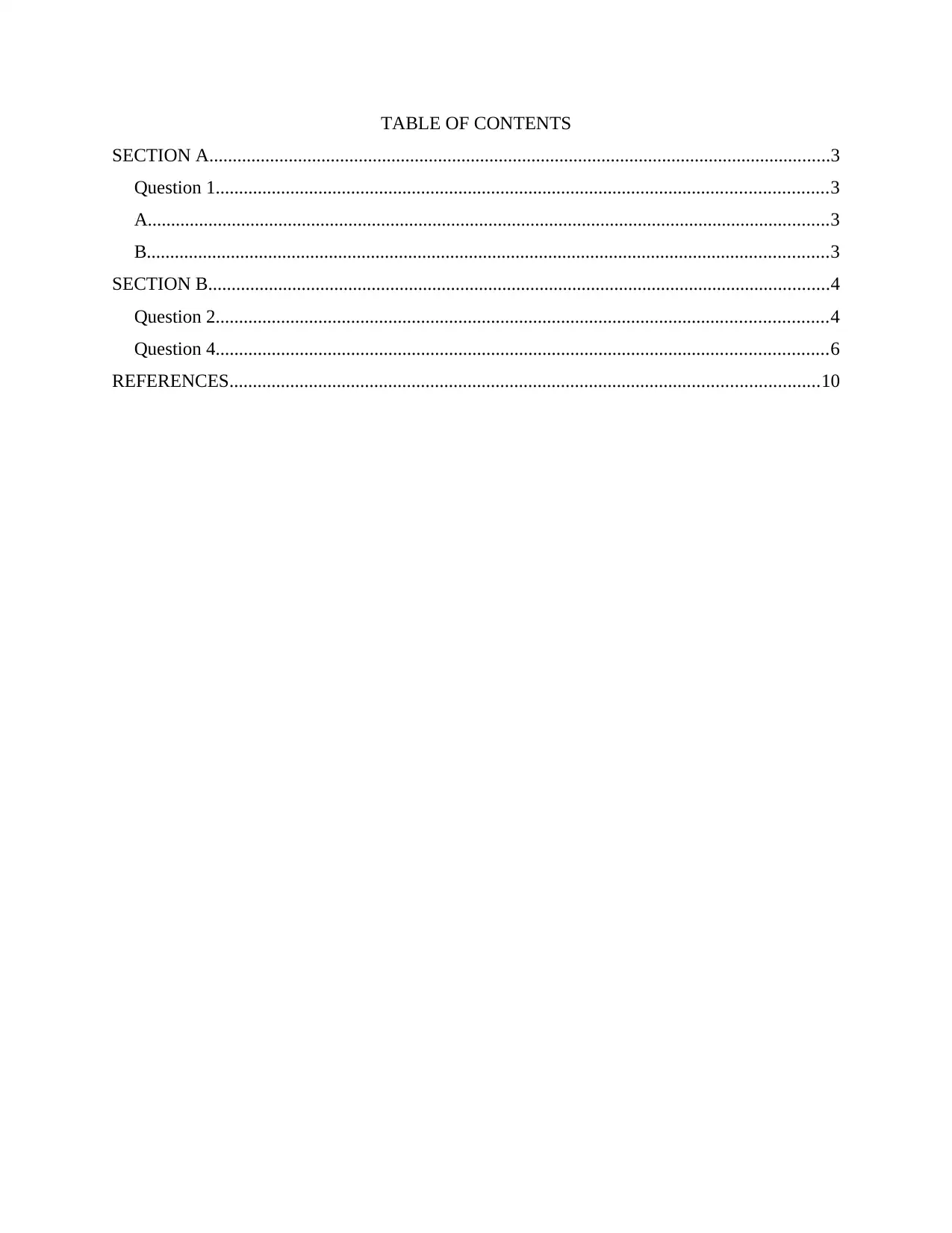
TABLE OF CONTENTS
SECTION A.....................................................................................................................................3
Question 1...................................................................................................................................3
A..................................................................................................................................................3
B..................................................................................................................................................3
SECTION B.....................................................................................................................................4
Question 2...................................................................................................................................4
Question 4...................................................................................................................................6
REFERENCES..............................................................................................................................10
SECTION A.....................................................................................................................................3
Question 1...................................................................................................................................3
A..................................................................................................................................................3
B..................................................................................................................................................3
SECTION B.....................................................................................................................................4
Question 2...................................................................................................................................4
Question 4...................................................................................................................................6
REFERENCES..............................................................................................................................10
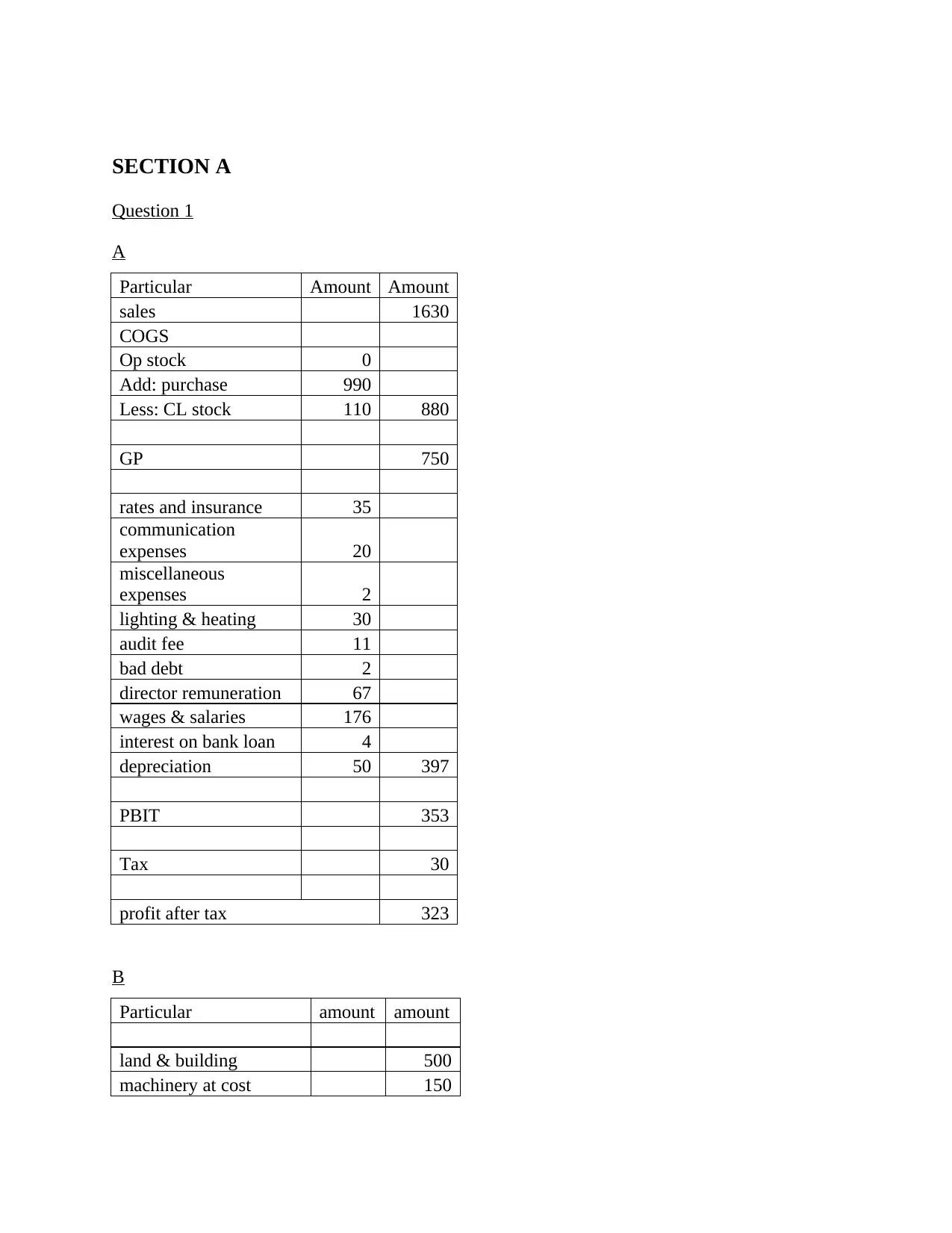
SECTION A
Question 1
A
Particular Amount Amount
sales 1630
COGS
Op stock 0
Add: purchase 990
Less: CL stock 110 880
GP 750
rates and insurance 35
communication
expenses 20
miscellaneous
expenses 2
lighting & heating 30
audit fee 11
bad debt 2
director remuneration 67
wages & salaries 176
interest on bank loan 4
depreciation 50 397
PBIT 353
Tax 30
profit after tax 323
B
Particular amount amount
land & building 500
machinery at cost 150
Question 1
A
Particular Amount Amount
sales 1630
COGS
Op stock 0
Add: purchase 990
Less: CL stock 110 880
GP 750
rates and insurance 35
communication
expenses 20
miscellaneous
expenses 2
lighting & heating 30
audit fee 11
bad debt 2
director remuneration 67
wages & salaries 176
interest on bank loan 4
depreciation 50 397
PBIT 353
Tax 30
profit after tax 323
B
Particular amount amount
land & building 500
machinery at cost 150
⊘ This is a preview!⊘
Do you want full access?
Subscribe today to unlock all pages.

Trusted by 1+ million students worldwide
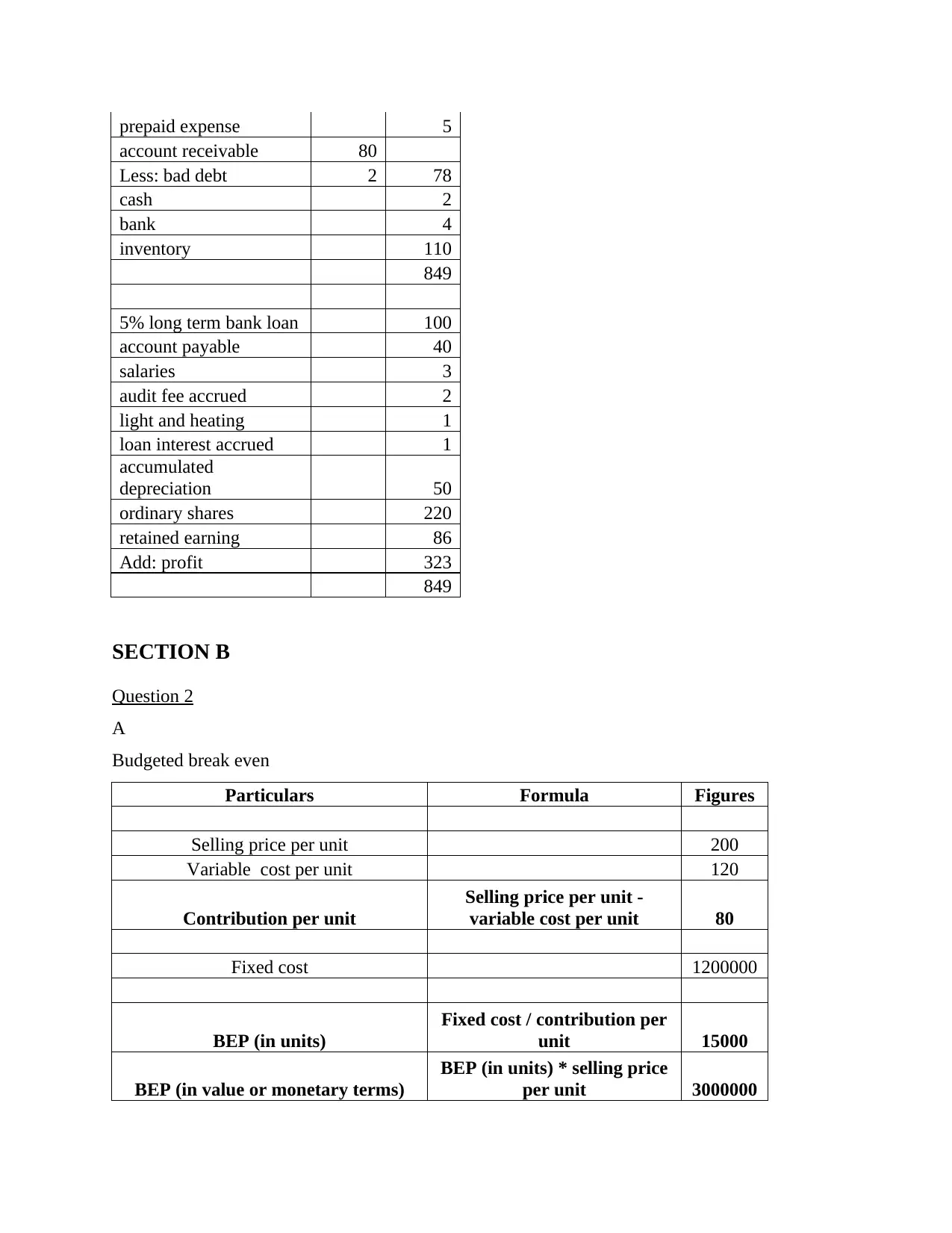
prepaid expense 5
account receivable 80
Less: bad debt 2 78
cash 2
bank 4
inventory 110
849
5% long term bank loan 100
account payable 40
salaries 3
audit fee accrued 2
light and heating 1
loan interest accrued 1
accumulated
depreciation 50
ordinary shares 220
retained earning 86
Add: profit 323
849
SECTION B
Question 2
A
Budgeted break even
Particulars Formula Figures
Selling price per unit 200
Variable cost per unit 120
Contribution per unit
Selling price per unit -
variable cost per unit 80
Fixed cost 1200000
BEP (in units)
Fixed cost / contribution per
unit 15000
BEP (in value or monetary terms)
BEP (in units) * selling price
per unit 3000000
account receivable 80
Less: bad debt 2 78
cash 2
bank 4
inventory 110
849
5% long term bank loan 100
account payable 40
salaries 3
audit fee accrued 2
light and heating 1
loan interest accrued 1
accumulated
depreciation 50
ordinary shares 220
retained earning 86
Add: profit 323
849
SECTION B
Question 2
A
Budgeted break even
Particulars Formula Figures
Selling price per unit 200
Variable cost per unit 120
Contribution per unit
Selling price per unit -
variable cost per unit 80
Fixed cost 1200000
BEP (in units)
Fixed cost / contribution per
unit 15000
BEP (in value or monetary terms)
BEP (in units) * selling price
per unit 3000000
Paraphrase This Document
Need a fresh take? Get an instant paraphrase of this document with our AI Paraphraser
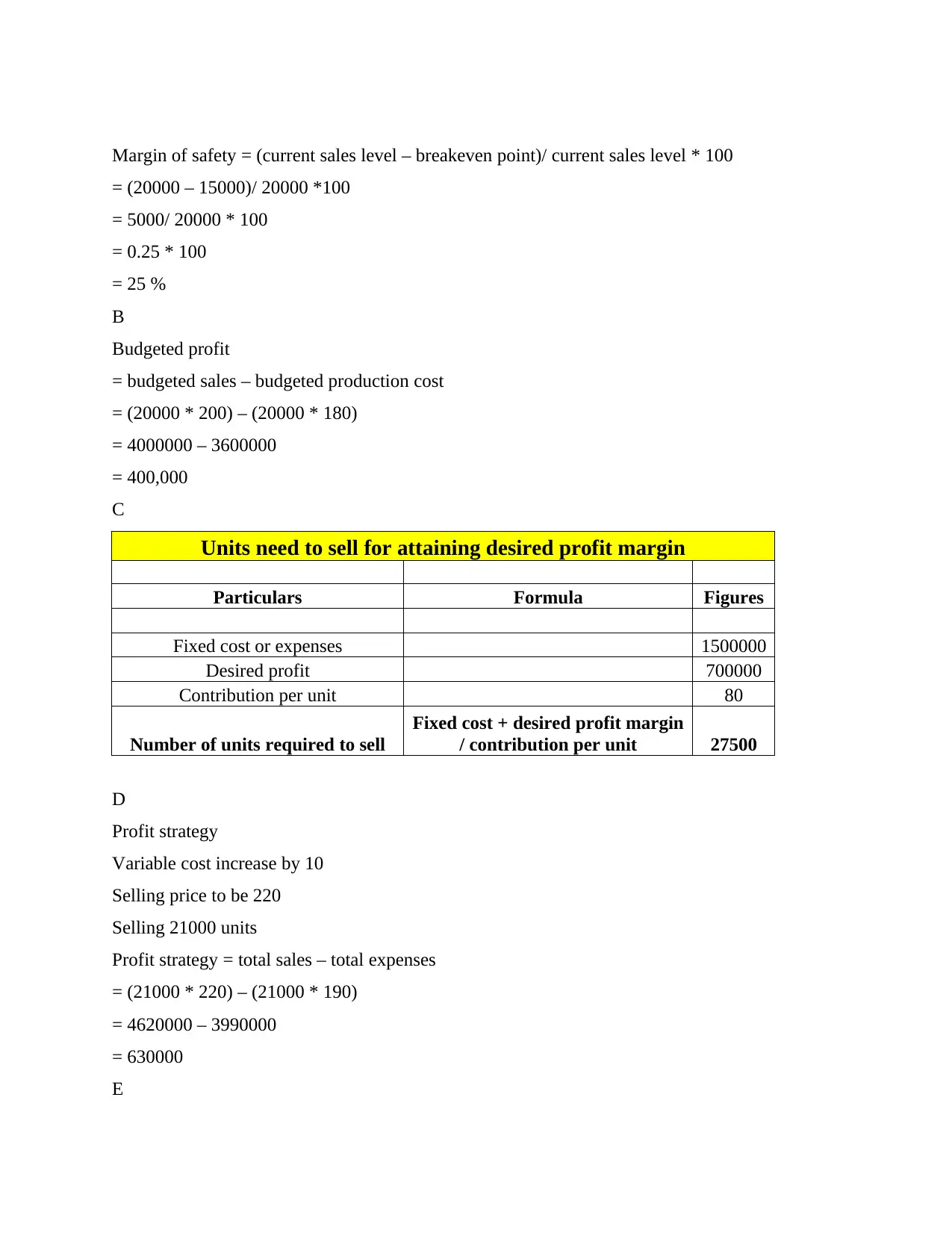
Margin of safety = (current sales level – breakeven point)/ current sales level * 100
= (20000 – 15000)/ 20000 *100
= 5000/ 20000 * 100
= 0.25 * 100
= 25 %
B
Budgeted profit
= budgeted sales – budgeted production cost
= (20000 * 200) – (20000 * 180)
= 4000000 – 3600000
= 400,000
C
Units need to sell for attaining desired profit margin
Particulars Formula Figures
Fixed cost or expenses 1500000
Desired profit 700000
Contribution per unit 80
Number of units required to sell
Fixed cost + desired profit margin
/ contribution per unit 27500
D
Profit strategy
Variable cost increase by 10
Selling price to be 220
Selling 21000 units
Profit strategy = total sales – total expenses
= (21000 * 220) – (21000 * 190)
= 4620000 – 3990000
= 630000
E
= (20000 – 15000)/ 20000 *100
= 5000/ 20000 * 100
= 0.25 * 100
= 25 %
B
Budgeted profit
= budgeted sales – budgeted production cost
= (20000 * 200) – (20000 * 180)
= 4000000 – 3600000
= 400,000
C
Units need to sell for attaining desired profit margin
Particulars Formula Figures
Fixed cost or expenses 1500000
Desired profit 700000
Contribution per unit 80
Number of units required to sell
Fixed cost + desired profit margin
/ contribution per unit 27500
D
Profit strategy
Variable cost increase by 10
Selling price to be 220
Selling 21000 units
Profit strategy = total sales – total expenses
= (21000 * 220) – (21000 * 190)
= 4620000 – 3990000
= 630000
E

With the above analysis it is clear that in case it is director proposed changes will be
applied that is spending 10 per unit additional and the selling price to be increased 220 per unit
and with the selling unit of 21000 the company will on a good amount of profit. This is
particularly because of the reason that when the company was selling 20000 units at that time the
budget and profit of the company was 400000. But in case some changes are being applied that is
increasing the variable cost a little bit and increasing the selling price as well along with the
number of units sold then the company will earn a profit of 630000. This is very good for the
company hence the assumptions made will definitely improve the performance of the company
and its profitability as well (Tanco, Cat and Garat, 2019).
Question 4
A
Payback period
Project A
Computation of Payback period
Year Cash inflows Cumulative cash inflows
1 240 240
2 240 480
3 240 720
4 240 960
5 240 1200
6 240 1440
7 240
Initial investment 700
Payback period 0.9
Payback period 2 year and 9 months
Project B
Computation of Payback period
Year Cash inflows Cumulative cash inflows
1 400 400
applied that is spending 10 per unit additional and the selling price to be increased 220 per unit
and with the selling unit of 21000 the company will on a good amount of profit. This is
particularly because of the reason that when the company was selling 20000 units at that time the
budget and profit of the company was 400000. But in case some changes are being applied that is
increasing the variable cost a little bit and increasing the selling price as well along with the
number of units sold then the company will earn a profit of 630000. This is very good for the
company hence the assumptions made will definitely improve the performance of the company
and its profitability as well (Tanco, Cat and Garat, 2019).
Question 4
A
Payback period
Project A
Computation of Payback period
Year Cash inflows Cumulative cash inflows
1 240 240
2 240 480
3 240 720
4 240 960
5 240 1200
6 240 1440
7 240
Initial investment 700
Payback period 0.9
Payback period 2 year and 9 months
Project B
Computation of Payback period
Year Cash inflows Cumulative cash inflows
1 400 400
⊘ This is a preview!⊘
Do you want full access?
Subscribe today to unlock all pages.

Trusted by 1+ million students worldwide
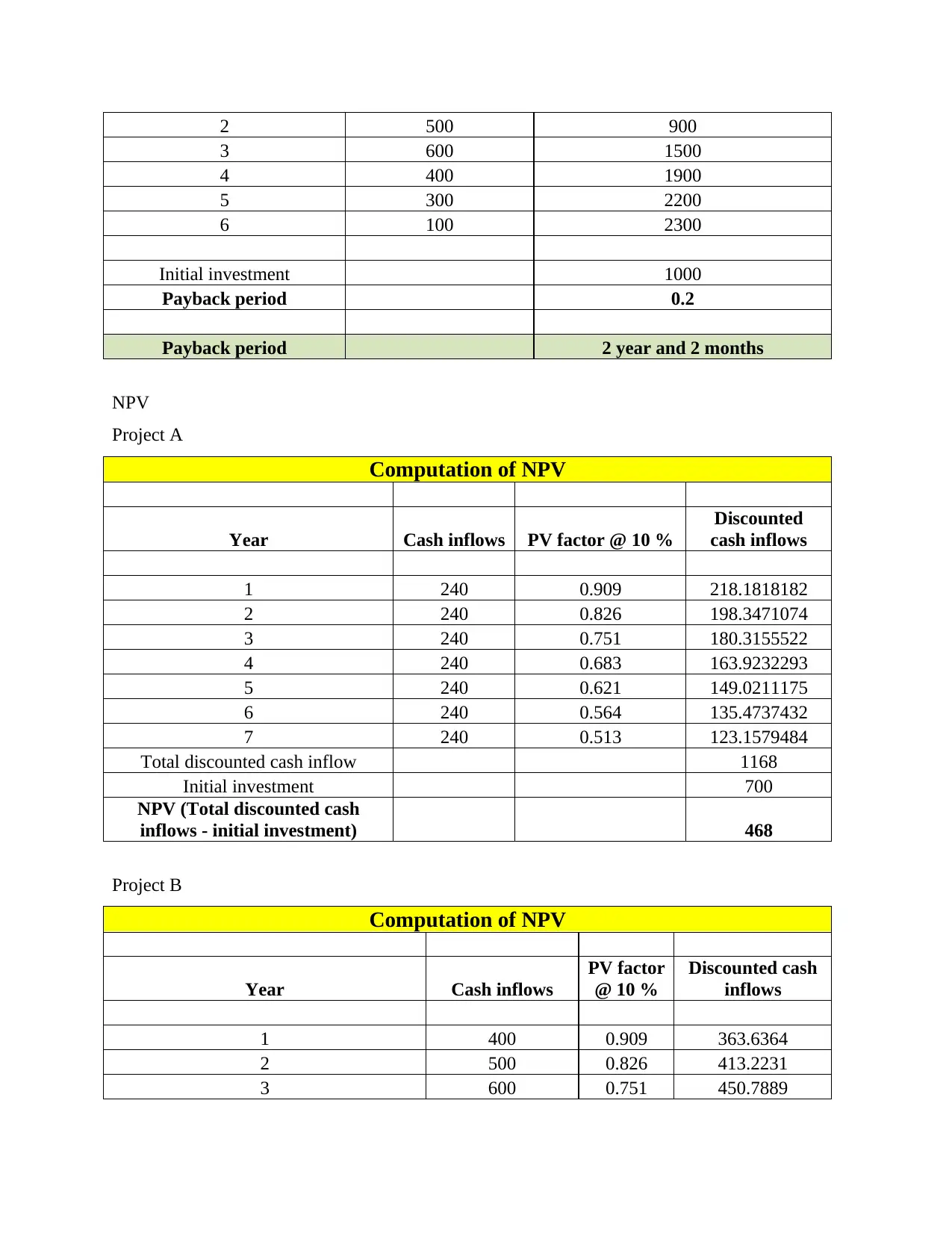
2 500 900
3 600 1500
4 400 1900
5 300 2200
6 100 2300
Initial investment 1000
Payback period 0.2
Payback period 2 year and 2 months
NPV
Project A
Computation of NPV
Year Cash inflows PV factor @ 10 %
Discounted
cash inflows
1 240 0.909 218.1818182
2 240 0.826 198.3471074
3 240 0.751 180.3155522
4 240 0.683 163.9232293
5 240 0.621 149.0211175
6 240 0.564 135.4737432
7 240 0.513 123.1579484
Total discounted cash inflow 1168
Initial investment 700
NPV (Total discounted cash
inflows - initial investment) 468
Project B
Computation of NPV
Year Cash inflows
PV factor
@ 10 %
Discounted cash
inflows
1 400 0.909 363.6364
2 500 0.826 413.2231
3 600 0.751 450.7889
3 600 1500
4 400 1900
5 300 2200
6 100 2300
Initial investment 1000
Payback period 0.2
Payback period 2 year and 2 months
NPV
Project A
Computation of NPV
Year Cash inflows PV factor @ 10 %
Discounted
cash inflows
1 240 0.909 218.1818182
2 240 0.826 198.3471074
3 240 0.751 180.3155522
4 240 0.683 163.9232293
5 240 0.621 149.0211175
6 240 0.564 135.4737432
7 240 0.513 123.1579484
Total discounted cash inflow 1168
Initial investment 700
NPV (Total discounted cash
inflows - initial investment) 468
Project B
Computation of NPV
Year Cash inflows
PV factor
@ 10 %
Discounted cash
inflows
1 400 0.909 363.6364
2 500 0.826 413.2231
3 600 0.751 450.7889
Paraphrase This Document
Need a fresh take? Get an instant paraphrase of this document with our AI Paraphraser
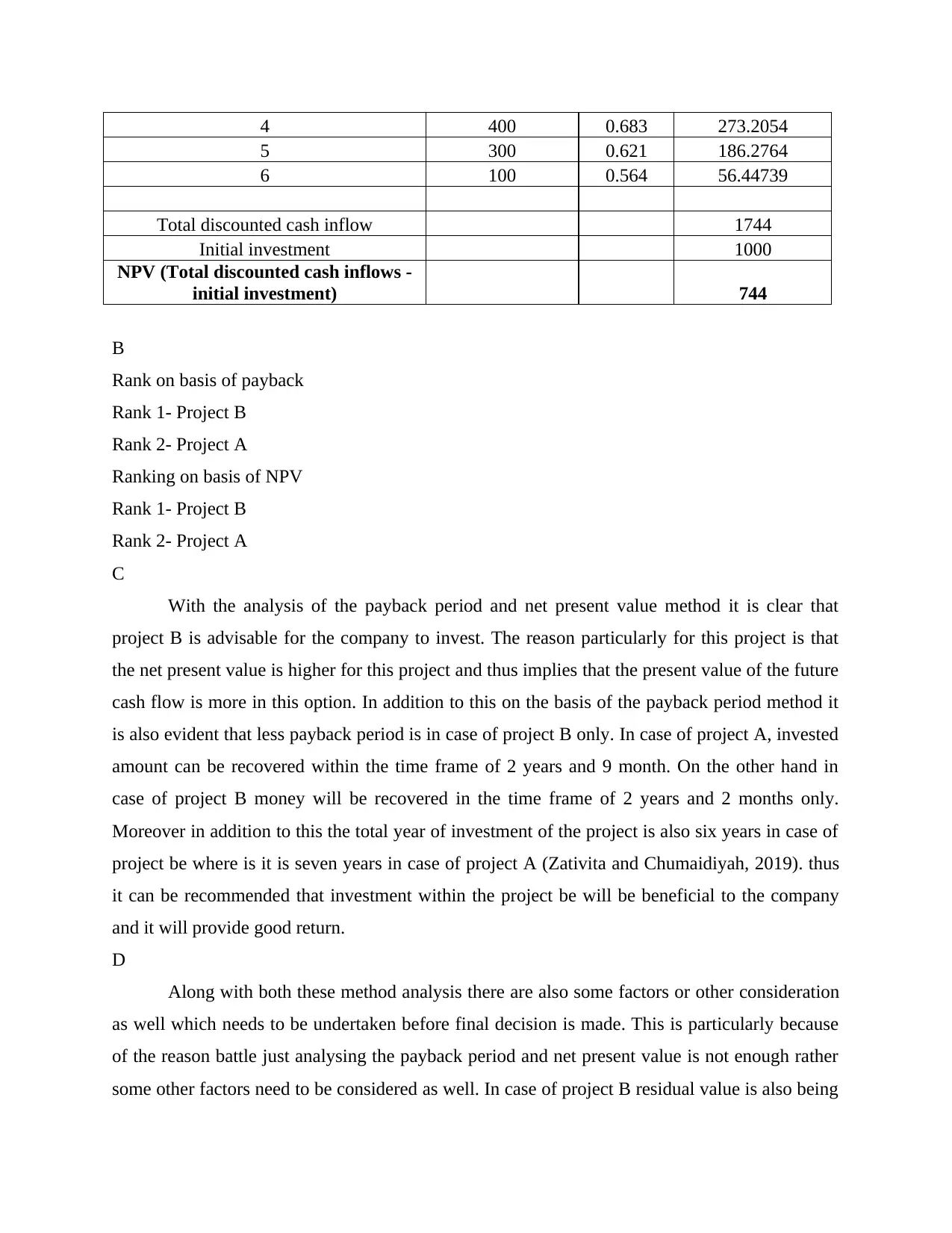
4 400 0.683 273.2054
5 300 0.621 186.2764
6 100 0.564 56.44739
Total discounted cash inflow 1744
Initial investment 1000
NPV (Total discounted cash inflows -
initial investment) 744
B
Rank on basis of payback
Rank 1- Project B
Rank 2- Project A
Ranking on basis of NPV
Rank 1- Project B
Rank 2- Project A
C
With the analysis of the payback period and net present value method it is clear that
project B is advisable for the company to invest. The reason particularly for this project is that
the net present value is higher for this project and thus implies that the present value of the future
cash flow is more in this option. In addition to this on the basis of the payback period method it
is also evident that less payback period is in case of project B only. In case of project A, invested
amount can be recovered within the time frame of 2 years and 9 month. On the other hand in
case of project B money will be recovered in the time frame of 2 years and 2 months only.
Moreover in addition to this the total year of investment of the project is also six years in case of
project be where is it is seven years in case of project A (Zativita and Chumaidiyah, 2019). thus
it can be recommended that investment within the project be will be beneficial to the company
and it will provide good return.
D
Along with both these method analysis there are also some factors or other consideration
as well which needs to be undertaken before final decision is made. This is particularly because
of the reason battle just analysing the payback period and net present value is not enough rather
some other factors need to be considered as well. In case of project B residual value is also being
5 300 0.621 186.2764
6 100 0.564 56.44739
Total discounted cash inflow 1744
Initial investment 1000
NPV (Total discounted cash inflows -
initial investment) 744
B
Rank on basis of payback
Rank 1- Project B
Rank 2- Project A
Ranking on basis of NPV
Rank 1- Project B
Rank 2- Project A
C
With the analysis of the payback period and net present value method it is clear that
project B is advisable for the company to invest. The reason particularly for this project is that
the net present value is higher for this project and thus implies that the present value of the future
cash flow is more in this option. In addition to this on the basis of the payback period method it
is also evident that less payback period is in case of project B only. In case of project A, invested
amount can be recovered within the time frame of 2 years and 9 month. On the other hand in
case of project B money will be recovered in the time frame of 2 years and 2 months only.
Moreover in addition to this the total year of investment of the project is also six years in case of
project be where is it is seven years in case of project A (Zativita and Chumaidiyah, 2019). thus
it can be recommended that investment within the project be will be beneficial to the company
and it will provide good return.
D
Along with both these method analysis there are also some factors or other consideration
as well which needs to be undertaken before final decision is made. This is particularly because
of the reason battle just analysing the payback period and net present value is not enough rather
some other factors need to be considered as well. In case of project B residual value is also being
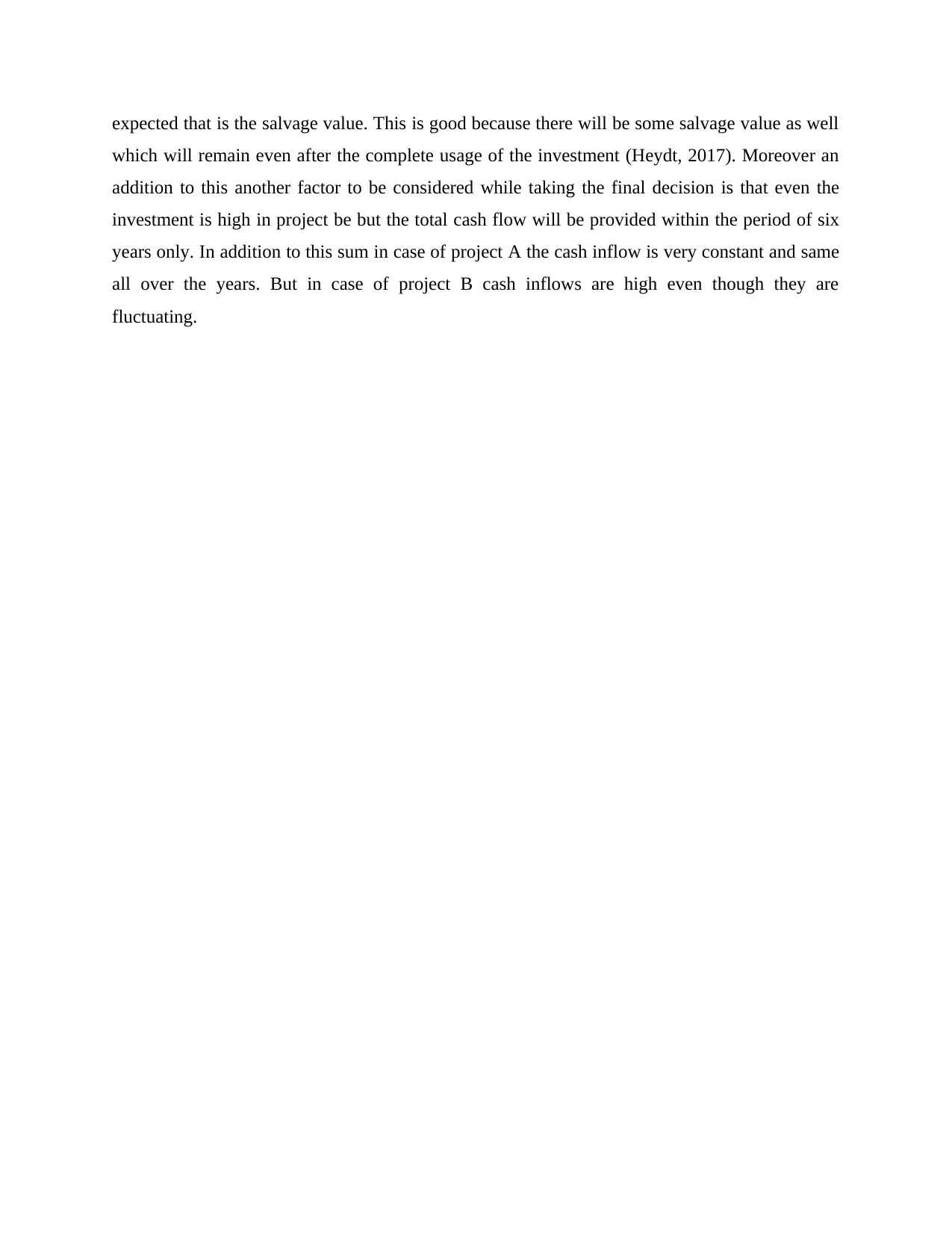
expected that is the salvage value. This is good because there will be some salvage value as well
which will remain even after the complete usage of the investment (Heydt, 2017). Moreover an
addition to this another factor to be considered while taking the final decision is that even the
investment is high in project be but the total cash flow will be provided within the period of six
years only. In addition to this sum in case of project A the cash inflow is very constant and same
all over the years. But in case of project B cash inflows are high even though they are
fluctuating.
which will remain even after the complete usage of the investment (Heydt, 2017). Moreover an
addition to this another factor to be considered while taking the final decision is that even the
investment is high in project be but the total cash flow will be provided within the period of six
years only. In addition to this sum in case of project A the cash inflow is very constant and same
all over the years. But in case of project B cash inflows are high even though they are
fluctuating.
⊘ This is a preview!⊘
Do you want full access?
Subscribe today to unlock all pages.

Trusted by 1+ million students worldwide
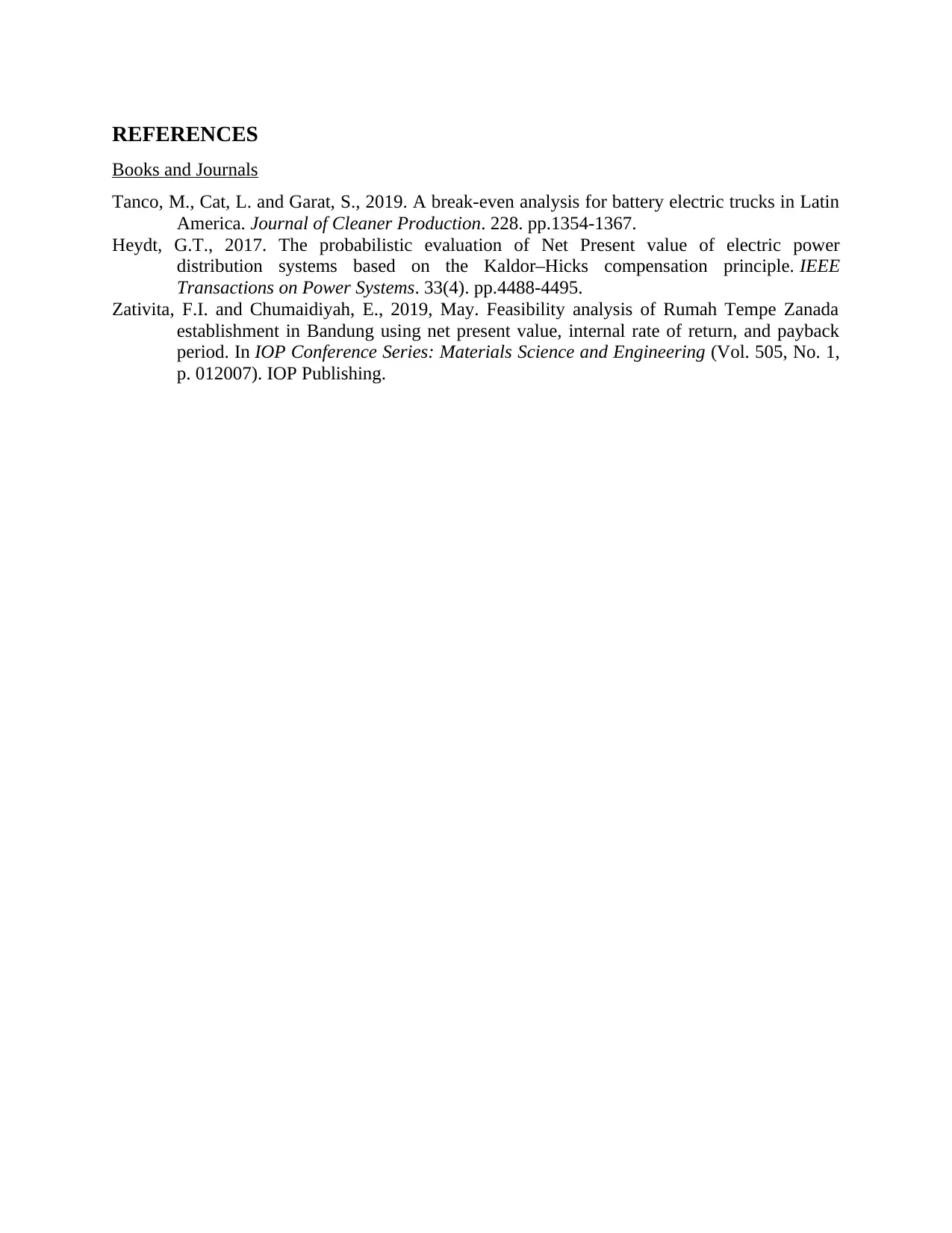
REFERENCES
Books and Journals
Tanco, M., Cat, L. and Garat, S., 2019. A break-even analysis for battery electric trucks in Latin
America. Journal of Cleaner Production. 228. pp.1354-1367.
Heydt, G.T., 2017. The probabilistic evaluation of Net Present value of electric power
distribution systems based on the Kaldor–Hicks compensation principle. IEEE
Transactions on Power Systems. 33(4). pp.4488-4495.
Zativita, F.I. and Chumaidiyah, E., 2019, May. Feasibility analysis of Rumah Tempe Zanada
establishment in Bandung using net present value, internal rate of return, and payback
period. In IOP Conference Series: Materials Science and Engineering (Vol. 505, No. 1,
p. 012007). IOP Publishing.
Books and Journals
Tanco, M., Cat, L. and Garat, S., 2019. A break-even analysis for battery electric trucks in Latin
America. Journal of Cleaner Production. 228. pp.1354-1367.
Heydt, G.T., 2017. The probabilistic evaluation of Net Present value of electric power
distribution systems based on the Kaldor–Hicks compensation principle. IEEE
Transactions on Power Systems. 33(4). pp.4488-4495.
Zativita, F.I. and Chumaidiyah, E., 2019, May. Feasibility analysis of Rumah Tempe Zanada
establishment in Bandung using net present value, internal rate of return, and payback
period. In IOP Conference Series: Materials Science and Engineering (Vol. 505, No. 1,
p. 012007). IOP Publishing.
1 out of 10
Related Documents
Your All-in-One AI-Powered Toolkit for Academic Success.
+13062052269
info@desklib.com
Available 24*7 on WhatsApp / Email
![[object Object]](/_next/static/media/star-bottom.7253800d.svg)
Unlock your academic potential
© 2024 | Zucol Services PVT LTD | All rights reserved.




